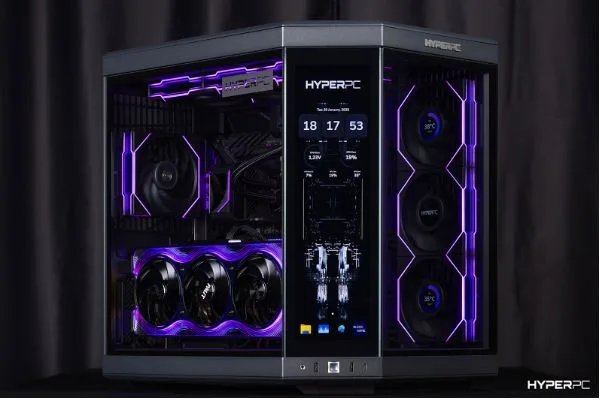CS 2 Demands More Than You Think: Here’s the PC You Need
While Counter-Strike 2 (CS 2) has modest system requirements on paper, achieving high and stable FPS is far from easy. The new physics, revamped engine, and heavy CPU load take their toll: on a weak or poorly configured PC, you’ll run into freezes, stuttering, and high input lag. This is especially noticeable on high-refresh-rate monitors (240Hz or 360Hz). In this article, we’ll break down what kind of PC you need for smooth, high-performance gameplay in Counter-Strike 2.
CPU for CS 2: Don’t Believe the Myths—Go With the Facts
Many believe CS 2 doesn’t need a powerful processor due to its low system requirements. That’s a misconception. Sure, an older Intel Core i3 can get you 60–100 FPS, but that’s not enough for a competitive shooter. Input lag becomes noticeable, and the gameplay won’t feel smooth.
To avoid these issues, you need a consistent 300+ FPS. The minimum CPU capable of that is the Intel Core i5-12400. However, even it may struggle during intense scenes, leading to frame drops. If you want uncompromised performance, look at more powerful CPUs like the Intel Core i5-14600K or AMD Ryzen 7 7700. These newer architectures deliver excellent performance even in demanding moments.
For the highest framerates, go with AMD Ryzen 7 7800X3D or 9800X3D. Their massive L3 cache helps push CS 2 beyond 400 FPS, ensuring buttery-smooth gameplay and ultra-low latency, even in the most chaotic scenes.
GPU for CS 2: Why Budget Graphics Cards Are Your Worst Enemy
A weak GPU is often the root of all problems in CS 2. It causes frame drops, freezes, stuttering, and inconsistent FPS—even if you have a strong CPU. The result? Screen tearing, jittery gameplay, and poor aim precision.
To avoid this, you need a modern, powerful graphics card that can reliably deliver 300+ FPS. Here are some recommendations:
- For Full HD: GeForce RTX 4060 or 5060
- For Quad HD: GeForce RTX 4070 Super or 5070
- For 4K: GeForce RTX 4080 Super, 5070 Ti, 5080, or 5090
To reduce input lag, enhance image clarity, and boost performance, set your graphics settings like this:
| Setting | Value |
| Player contrast enhancement | On |
| Vertical sync (V-Sync) | Off |
| Anti-aliasing mode | 4X MSAA or 8X MSAA |
| Shadow quality | High |
| Model & texture detail | Medium |
| Texture filtering mode | Bilinear |
| Shader detail | Low |
| Particle detail | Low |
| Global shadowing | Off |
| HDR | Quality |
| FidelityFX Super Resolution | Off |
| NVIDIA Reflex Low Latency | Off |
RAM and Storage Matter Just as Much as CPU and GPU
CS 2 isn’t overly demanding when it comes to RAM—16 GB is enough. However, if you plan to run a browser, chat apps, OBS, or other programs while playing, go for 32 GB to avoid stuttering and FPS drops.
You can install CS 2 on an HDD, but it’s not ideal. HDDs often cause long loading times, freezes, and lags—especially when joining servers, switching maps, or loading textures. To avoid this, install the game on an SSD. It dramatically improves loading speeds and eliminates micro-stutters.
The Hidden PC Requirements for CS 2 That Retailers Won’t Tell You
CPU, GPU, RAM, and storage are crucial, but don’t overlook cooling systems, build quality, warranty conditions, avoidance of used parts, and tech support availability. These factors impact both performance and lifespan.
Reputable manufacturers like HYPERPC usually get these right, but lesser-known brands from marketplaces often don’t. So be careful when choosing a gaming PC. Otherwise, you may end up with a machine full of headaches instead of one ready for elite gaming.
FAQ
Can I play CS 2 from an HDD instead of an SSD?
You can, but you shouldn’t. HDDs load maps and textures slowly, causing stuttering and delays. SSDs offer faster loading and smoother gameplay, especially during server joins and map transitions.
Why aim for 300 FPS if my monitor only supports 144 Hz?
Higher FPS reduces input lag and makes motion more predictable. Even on a 144Hz monitor, 300 FPS delivers a smoother experience than 144 FPS. In CS 2, every millisecond counts.
Why lower graphics settings on a high-end PC?
Even on powerful PCs, ultra graphics settings can increase input lag and reduce FPS stability. In CS 2, responsiveness and consistency matter more than visual fidelity. Lowering settings helps maximize framerate and minimize latency—essential for competitive play. That’s why many pro players prioritize performance over eye candy.
Let me know if you’d like a version formatted for web, PDF, or another style.





